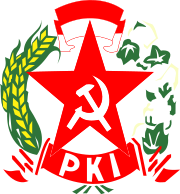Communist Party of Indonesia Partai Komunis Indonesia | |
|---|---|
 | |
| Abbreviation | PKI |
| Founder | Henk Sneevliet |
| Founded | 23 May 1914[a] |
| Banned | 5 July 1966[1] |
| Headquarters | Jakarta |
| Newspaper | Harian Rakjat |
| Student wing | Consentrasi Gerakan Mahasiswa Indonesia |
| Youth wing | People's Youth |
| Women's wing | Gerwani |
| Labour wing | Central All-Indonesian Workers Organization |
| Peasant wing | Peasants Front of Indonesia |
| Membership (1960) | 3,000,000–4,000,000 |
| Ideology | |
| National affiliation | People's Democratic Front (1948) |
| International affiliation | Comintern (until 1943) |
| Colours | Red |
| Slogan | Para Buruh Seluruh Dunia, Bersatulah! (Workers of the world, unite!) |
| Anthem | Pujaan Kepada Partai
Internasionale (The Internationale) |
| Election symbol | |
| Hammer and sickle | |
| Party flag | |
 | |
| Part of a series on |
| Communist parties |
|---|
The Communist Party of Indonesia (Indonesian: Partai Komunis Indonesia, PKI) was a communist party in the Dutch East Indies and later Indonesia. It was the largest non-ruling communist party in the world before its violent disbandment in 1965. The party had two million members in the 1955 elections, with 16 percent of the national vote and almost 30 percent of the vote in East Java.[2] During most of the period immediately following the Indonesian Independence until the eradication of the PKI in 1965, it was a legal party operating openly in the country.[3] Accused of responsibility for the 1965 army-led coup attempt, the party was banned by General Suharto in March 1966.[4]
Cite error: There are <ref group=lower-alpha> tags or {{efn}} templates on this page, but the references will not show without a {{reflist|group=lower-alpha}} template or {{notelist}} template (see the help page).
- ^ "Begini Isi TAP MPRS Nomor XXV/MPRS/1966 yang Disinggung Jenderal Andika Perkasa". April 2022.
- ^ De Jong, Alex (1 February 2019). "The Indonesian Counter-Revolution". Jacobin. Archived from the original on 24 April 2024.
- ^ Bevins, Vincent (20 October 2017). "What the United States Did in Indonesia". The Atlantic. Archived from the original on 9 August 2024. Retrieved 22 October 2017.
- ^ Crouch 1978, p. 192.